Slowly working my way up in the percent whole wheat in my Hokkaido sourdough milk breads. 75% is the highest so far and I think it was quite successful. I’m not sure how much higher I can go and still get the result that I’d like. I did change things this time to add an autolyse because a majority of the flour is stoneground whole wheat.
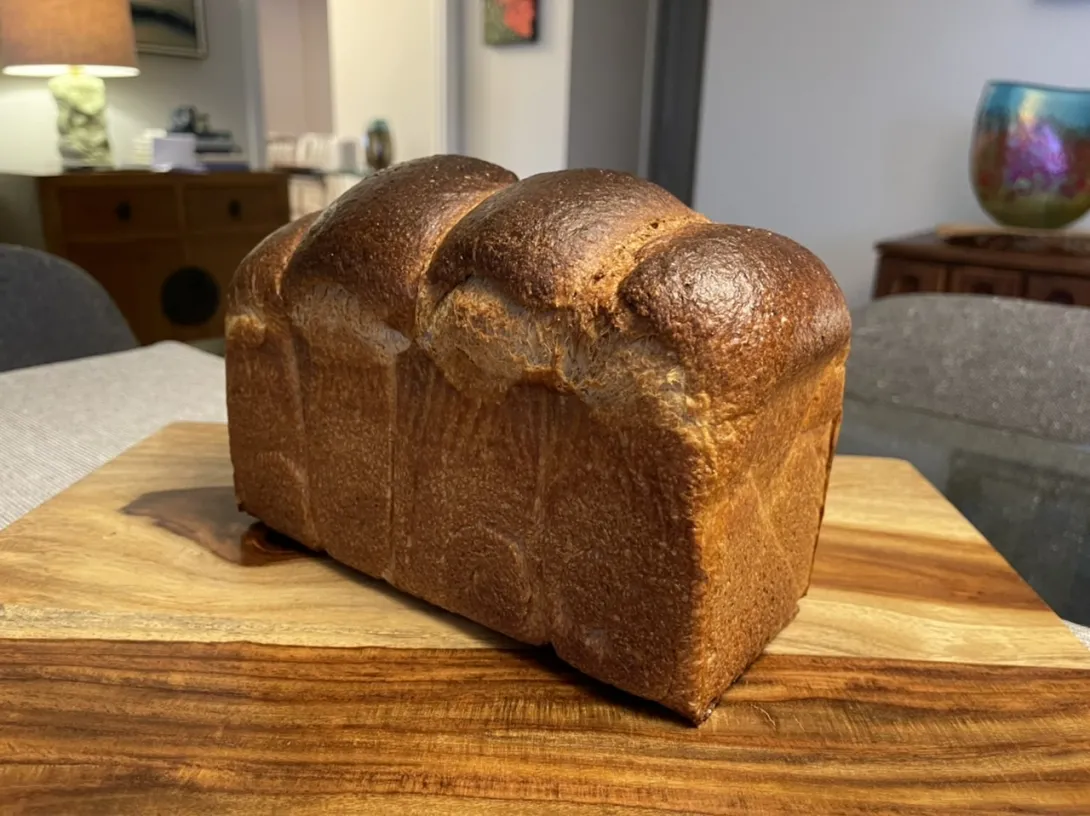
For one loaf 9x4x4” Pullman pan
Ingredients
Sweet Stiff Starter
• 53g bread flour
• 24g water
• 18g light brown sugar
• 18g sourdough starter ~100% hydration
1:1.33:2.9:1 starter:water:flour:sugar
@ 76ºF 10 hour not at peak
Tangzhong classic 1:5 ratio
• 89g milk (adjusted down to 1:5 ratio from original)
• 18g Whole Wheat flour
Dough Dry Ingredients
• 55 bread flour
· 305 g whole wheat
• 54g sugar 12.5%
• 7g salt 1.6%
Dough Wet Ingredients
• 169g milk 36.8%
• 50g egg beaten (about 1 lg egg)
• 60g butter 13.9% softened but do not melt, unless you are mixing with the mixer then melt. Combine with 30 g of flour to make easier to add to dough if hand mixing.
Pre-bake Wash
• 1 egg beaten
• 1 Tbsp milk
Instructions
Starter
Mix the starter ingredients in a jar or pyrex container with space for at least 50% growth. (See gallery where 150ml grows to approximately 225ml.)
Press down with your knuckles to create a uniform surface and to push out air.
At room temperature, it typically takes 7-9 hours for this sweet stiff levain to be at peak.
Tangzhong
In a sauce pan set on med-low heat, whisk the milk and flour until blended. Then cook for several minutes until thickened, stirring regularly with a spoon or heat-resistant spatula. Let cool in the pan or, for faster results, in a new bowl.
For my first bake, in the morning mixed the wet ingredients including the tangzhong with all the whole wheat flour to allow the bran to hydrate for 1.5 hours. Added levain next and mixed to incorporate.
Next added sugar, salt and bread flour and mixed to incorporate, rest 10 mins. Mixed until very good gluten development and windowpane.
Transfer the dough to a lightly oiled bowl, form it into a ball, flip it smooth side up, cover and let rise for 6-12 hours depending on room temperature. Bulk lasted 5 hours at 82ºF. You can place the dough into the fridge to chill the dough for about 1.5 hours, this makes rolling the dough easier. I didn’t do that this time.
Prepare your pans by greasing them or line with parchment paper.
Scrape the dough out onto a clean counter top. Lightly flour the bench. Press the dough into a rectangle and divide it into four. Shape each tightly into a boule, allow to rest 5 mins. Using a rolling pin roll each ball out and then letterfold. Turn 90* and using a rolling pin roll each out to at least 8”. Roll each into a tight roll with some tension. Arrange the rolls of dough inside your lined pan alternating the direction of the swirls. This should allow a greater rise during proof and in the oven.
Cover and let proof for 4-6 hours (more if you put the dough in the refrigerator). I proof until the top of the dough comes to within 1 cm of the top edge of the pan.
Preheat the oven to 350F and brush the dough with the egg-milk wash.
Bake the loaves for 50 minutes or until the internal temperature is at least 190F. Shield your loaf if it gets brown early in the baking process. After 50 mins remove the bread from the pan and bake a further 10 mins by placing the loaf directly in the oven on the rack with the oven turned down to 325ºF. You can brush the top of the loaf with butter if you wish at this point while the bread is still hot.
I’m quite pleased with the oven spring this dough was able to achieve with this much whole wheat. I think going higher than 75% I’ll probably need to add some vital wheat gluten in order to attain a shreddable crumb which is a characteristic of this style of bread.
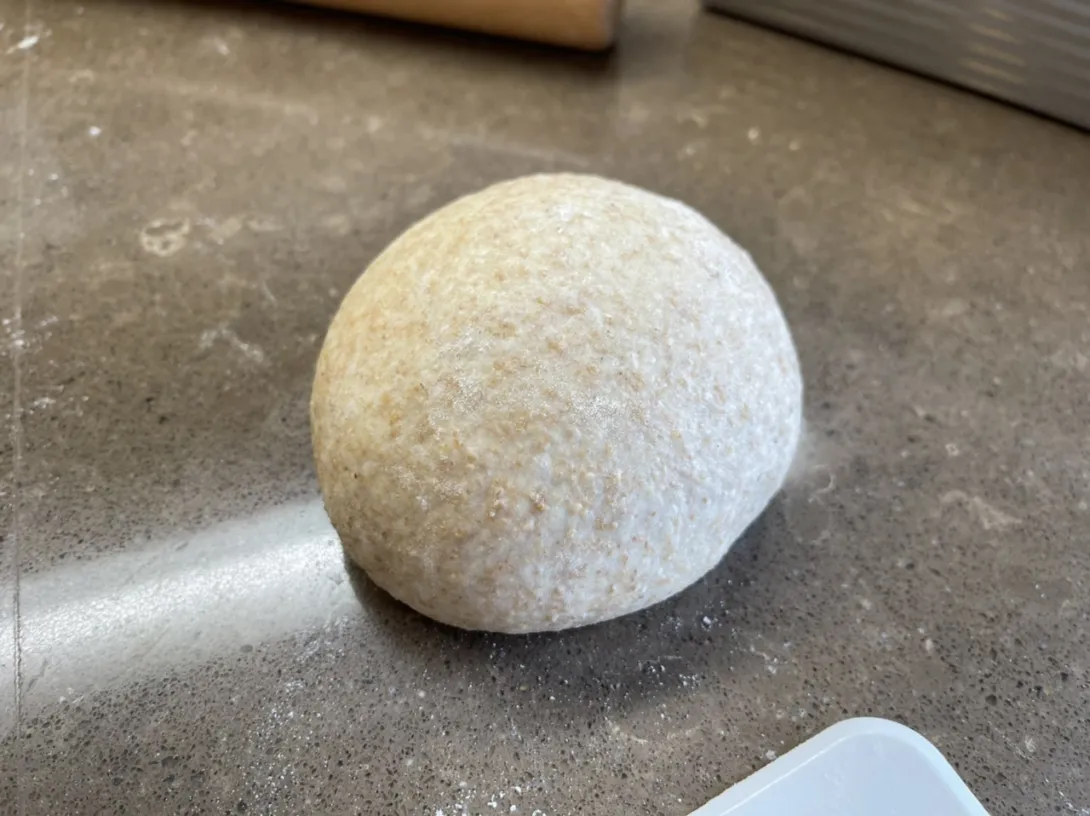
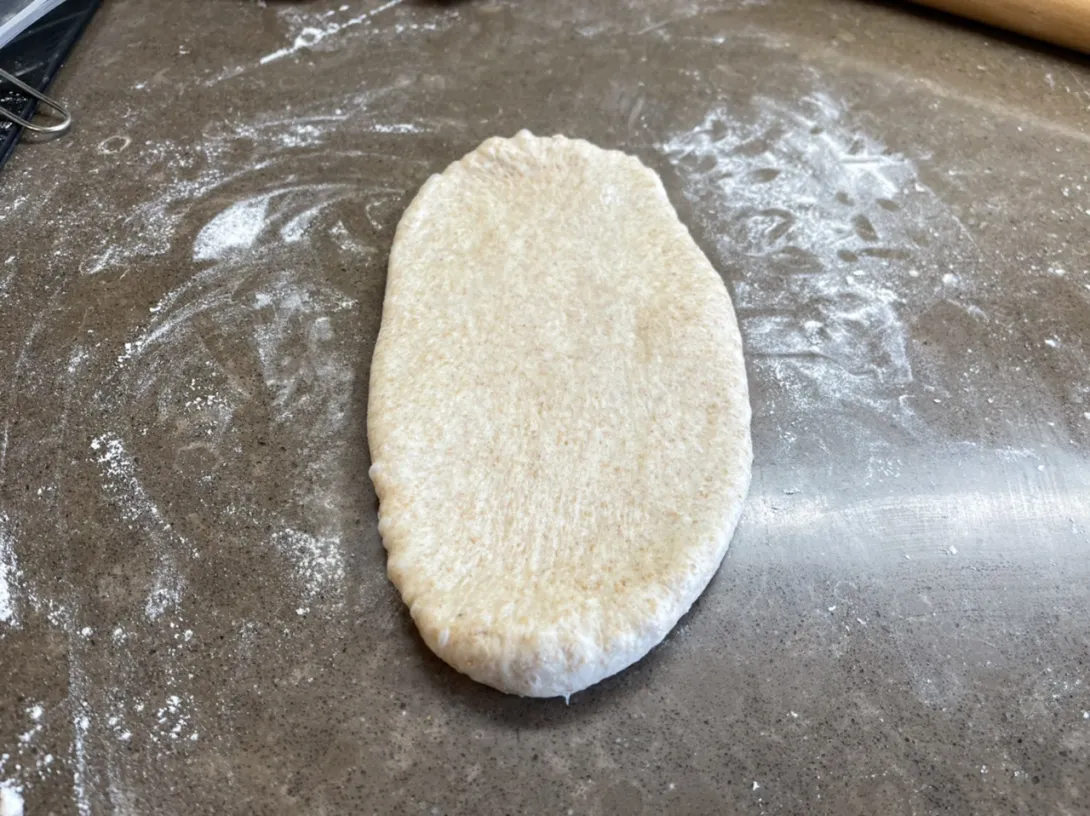
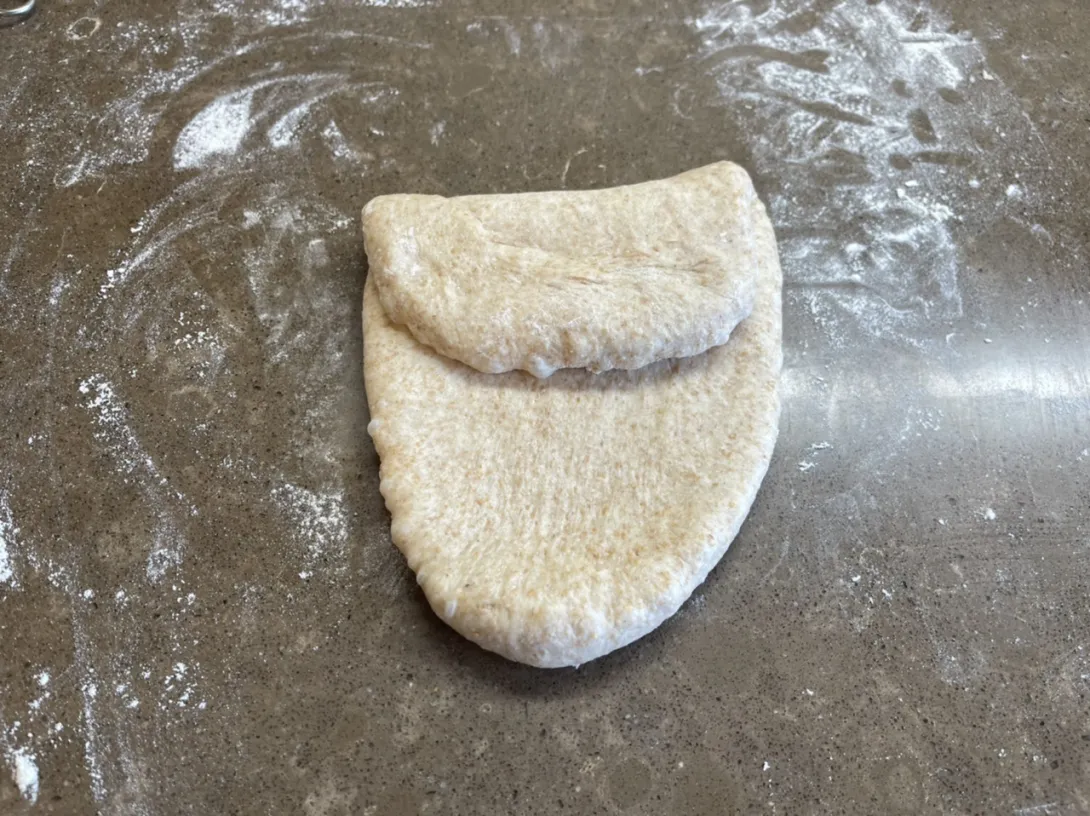
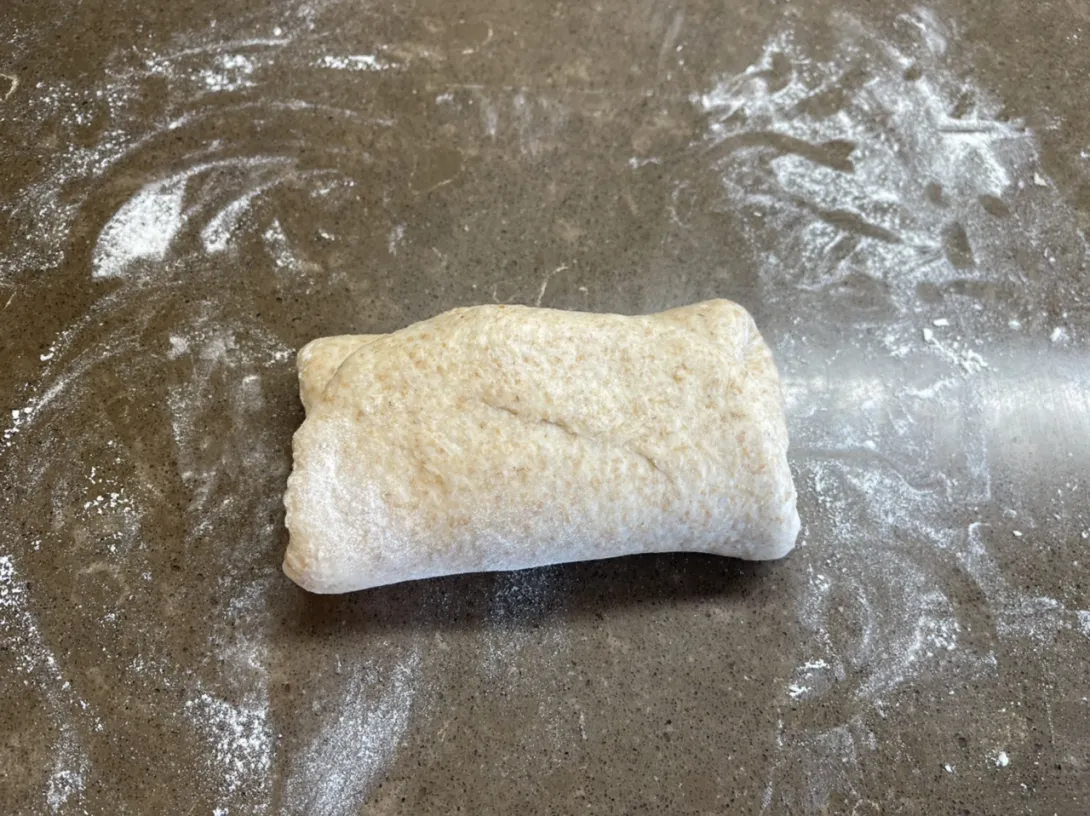
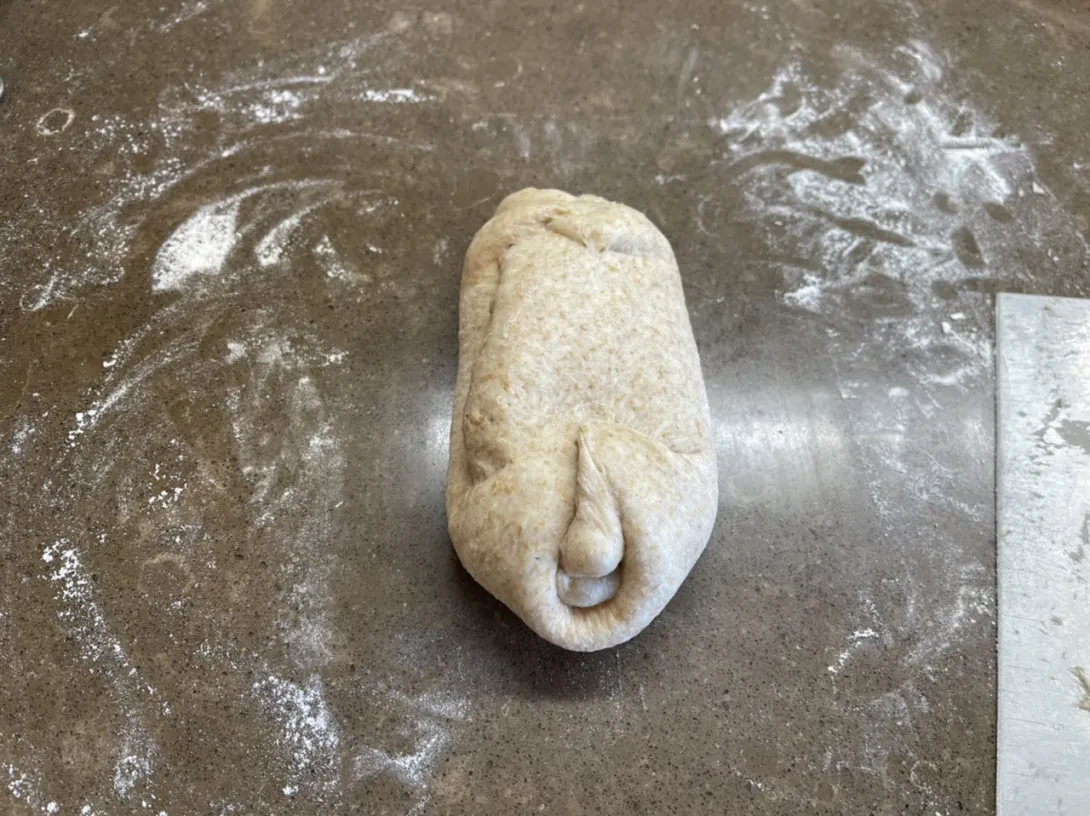
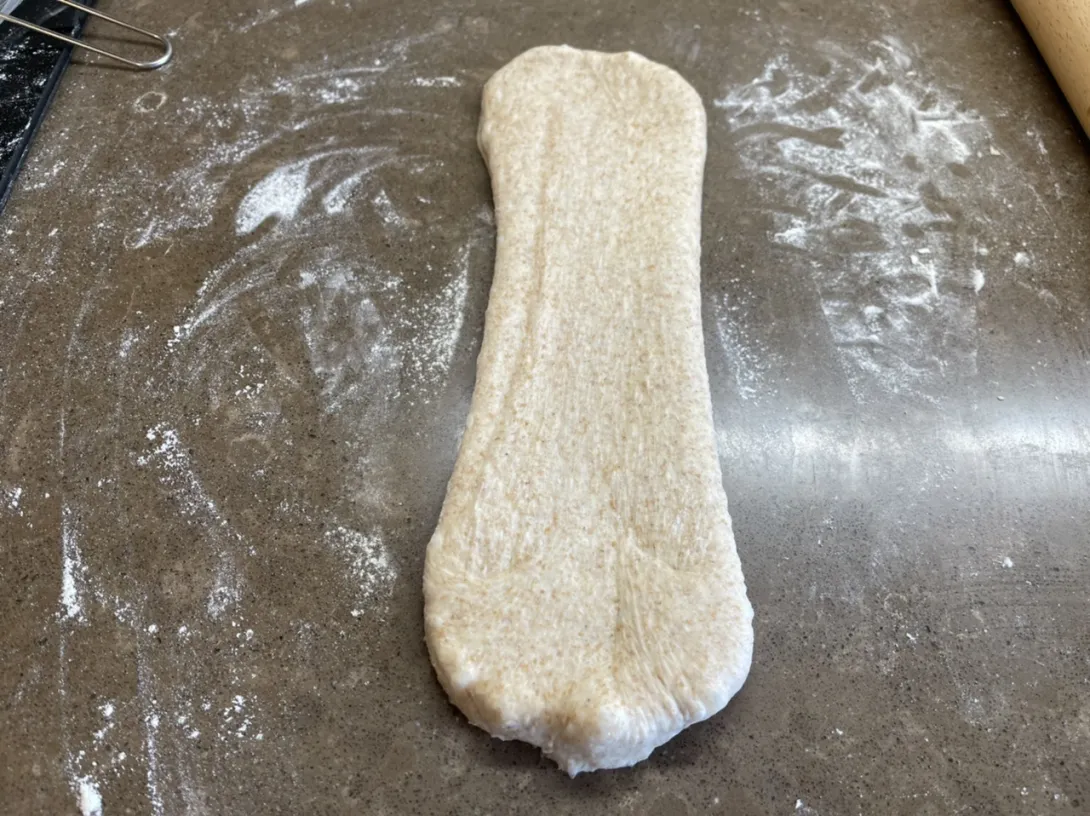
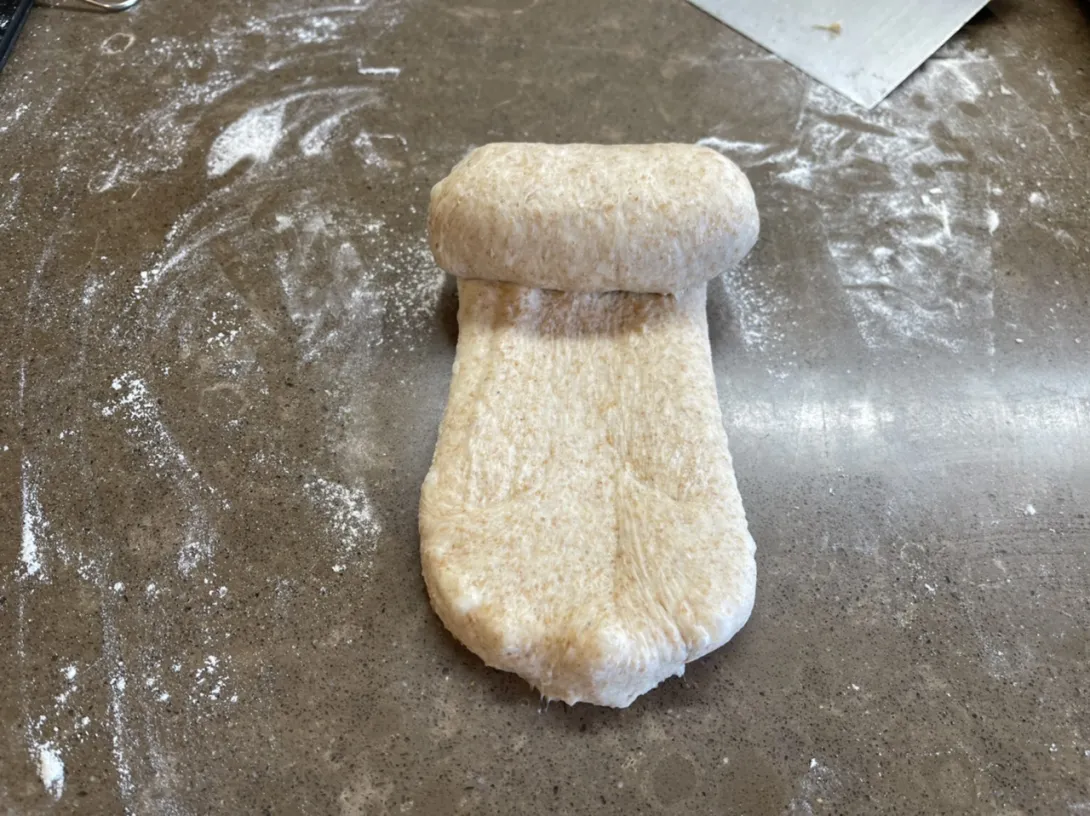
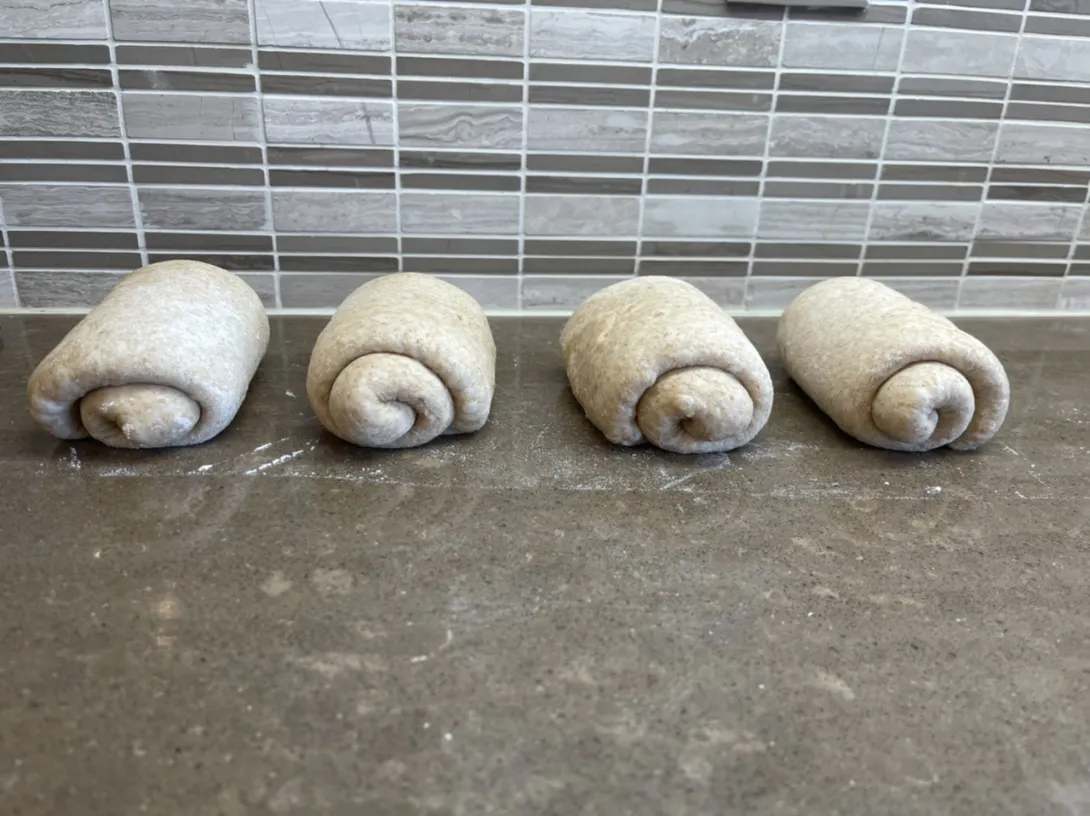
Alternate the direction of the swirls for better rise.
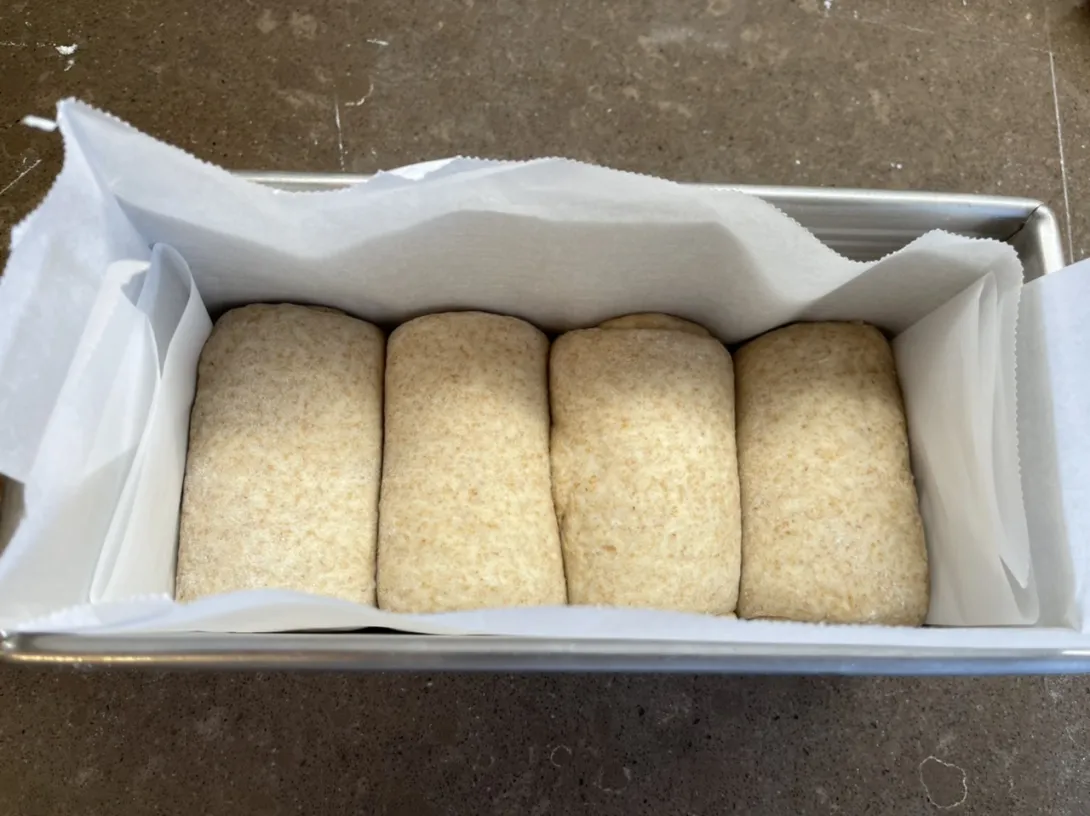
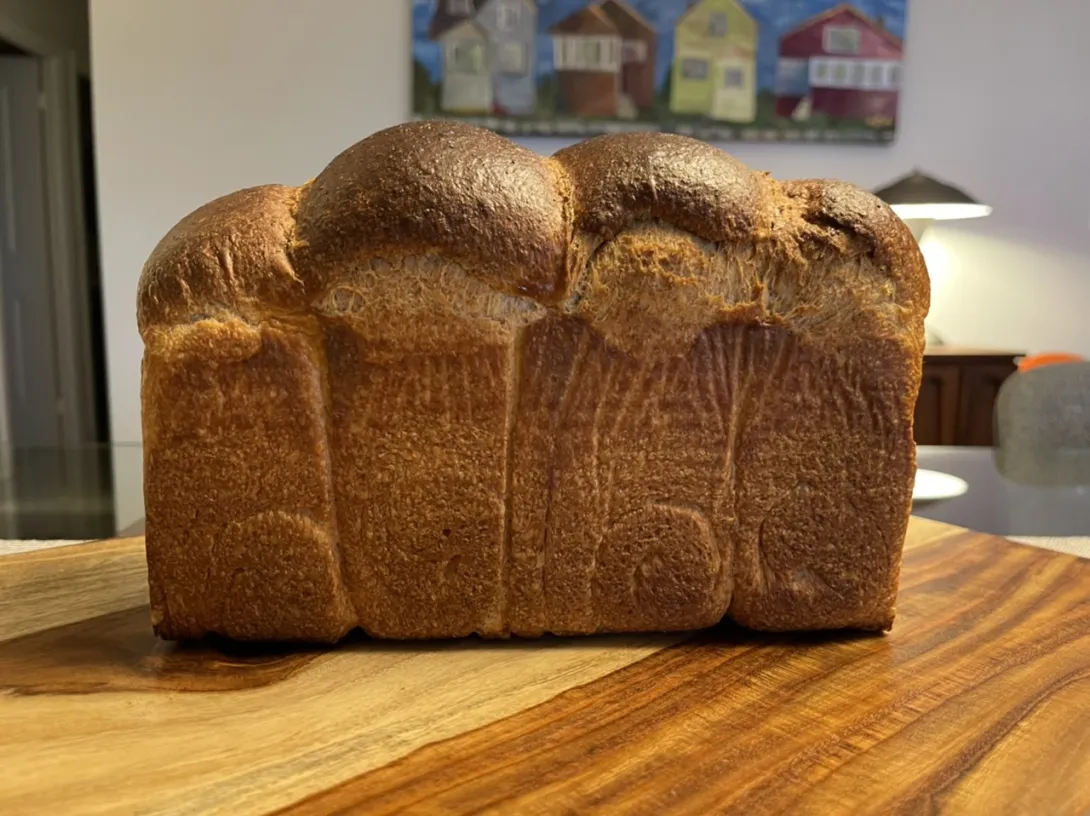
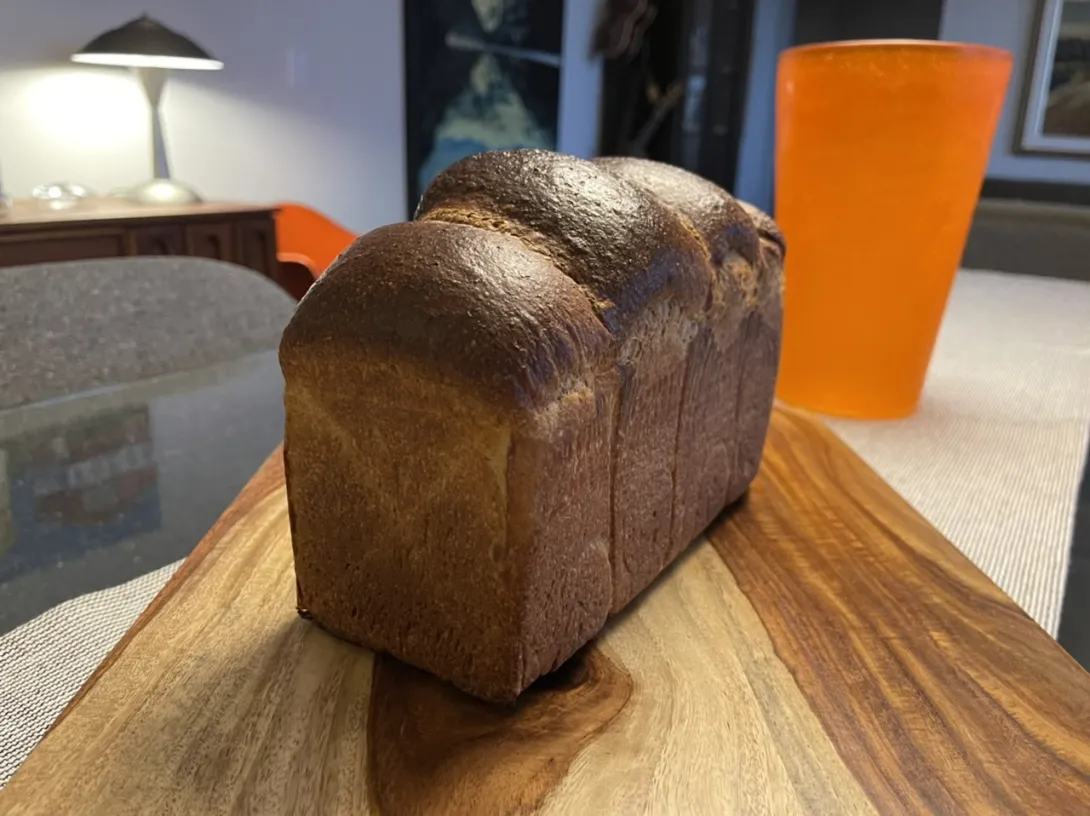
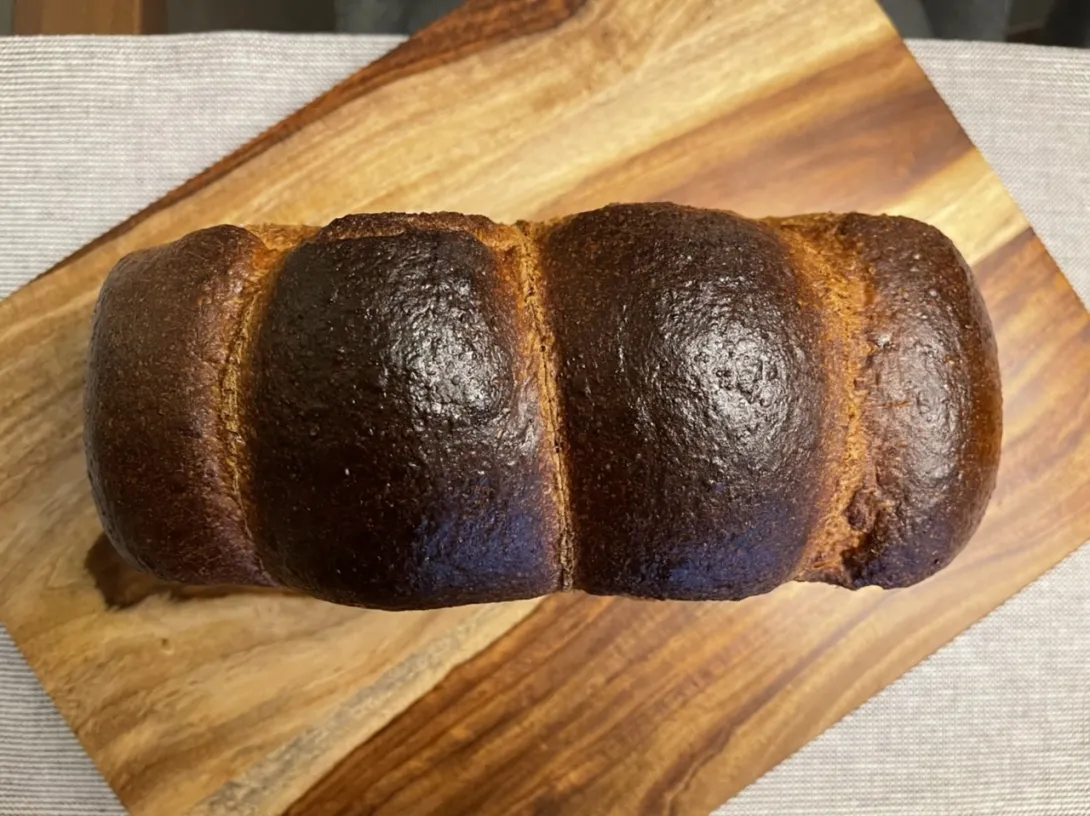
- Benito's Blog
- Log in or register to post comments
You have really got the Hokkaido bread down pat. Lovely color . What percent would you increase the formula for the 13" pullman ? I would like to give this a try . Thank you . c
Thank you Caroline. For a 13x4x4 Pullman the volume is 44% larger so I would increase by 40% or so. Let me know how you like it if you do try it.
Benny
I will likely get to it next week. More time then. Thank you ! c
Nice work. Can't wait for the crumb shot.
Amazed that growing up, whole grain bread was always pretty terrible. Apparently just badly made by commcercial sellers. Scalding does wonders for it.
You can try gluten but you might just increase % gelatinization. With a yudane in my baguettes I abandoned 24g of gluten I used to put in the baguettes. One possibility is to sift out the bran and add it into your tangzhong.
So true, I’ve always thought I disliked whole wheat bread. Even as recently as earlier this year I still thought I didn’t like it and was reluctant to bake with very much because of the horrible brown bread we used to eat. As I’m making my own breads with more whole grains I’m finding that I actually can love the flavour of at least a good portion of whole wheat.
For baguettes I’ve never worried too much about gluten, in fact we found last summer baking baguettes in the community bake that they turned out better with little gluten development and with low ish protein flour 10-11%.
I’ve yet to try sifting out the bran and hydrating it separately. I only have one sieve and I’m not sure it is fine enough. The only way to find out is to try though isn’t it.
Benny
Gorgeous as usual Benny. Can't wait to see the crumb.
Me too, I’m a bit anxious about opening this up, hoping not to find big holes/gaps.
I like this bake. I've never tried the Tangzhong method and looks interesting. You got good final proof rise and during the bake. Well done.
Cheers,
Gavin
Yes it did ferment nicely, much more quickly than when using only white flour. As you know enrichments slow things down, so having the high whole grain really helps counter that. Also, I used a stiff sweet levain. These types of levains seems to have a positive effect on yeast activity so they tend to work really well when making an enriched dough too.
I’m so pleased with this bake my first time at 75% whole wheat for this style of bread. The crumb still had that great shreddable crumb that I was hoping for. The bread is delicious if I can say so myself and didn’t disappoint me in any way. A fix for the gaps between rolls that I would sometimes get is simple, make sure you press each roll down and together as you add them to the pan and down again after they are all in place.
Wowwww! Nice.
Love your point about whole wheat counteracting slowing of enriched doughs.
Whole grains have a lot to offer when it comes to fermentation and flavour.
Thanks so much David. I’m super happy with this bake and now I’m wondering, but doubt, that I could make a similarly shreddable 100% whole wheat version. I’d probably have to add vital wheat gluten to do it though. Something to ponder and consider for the future. For now, I’m happy that I can bake a good hokkaido sourdough milk bread with 75% whole wheat.
You may not need the VWG is you can get whole-wheat flour >14% protein.
The stoneground whole wheat flour that I have is 13.38% protein so I should probably get it up above 14% then based on your experience.
Benny
Definitely going to try it out. I’ve gotten that crumb from using the lid on my Pullman and a multigrain mix without anything extra. Will be fun to make two different doughs and compare!
I’m looking forward to your bakes Caroline.
Benny
Great result Benny. Great sandwich slices. I'm baking another 100% whole-wheat sandwich bread today as my family take half the loaf home.
Gavin you’ve inspired me to gradually increase my whole grain percentage in these sandwich loaves so thank you.
Benny
Any leftovers? :p
I was making some with Kamut recently and I wanna make another with the lid on. Bookmarked yours as a guide when I test this with atta flour. Thank you Benny!
- Christi
Thank you Christi. I can imagine this being really great with Kamut, what a great idea. I look forward to your rendition of this bread.
Benny
So perfectly gorgeous. I would eat this with some Eagle Brand sweetened condensed milk. 🤤
Thank you LL, we had tuna sandwiches using this bread for dinner last night, really delicious.
I can’t believe that you got such a nice shreddable (is that a word?) crumb out of 75% wheat! Just wow!
Thank you Danni, it may or may not be a word, it may just be a neologism if it is not. I’m a bit surprised that the crumb turned out so well, I was sort of dreading opening this one up.
even if it’s not exactly what you want, it still will taste good! Ha ha!
Hey I love this outcome! I just wrote out your recipe to try that next time I bake but with beer and spent grain. Yes, I know I'm weird but I need a new challenge and use up the increasing bags of spent grain in my fridge. :) I'm still trying to come up with a more whole grain soft bread for sandwiches that I can incorporate spent grain into as well. I'll keep you posted how this works out. You're way more scientific with your recipes than anybody I know; I'm like totally random! :) I've actually made Tangzhong with beer before instead of milk, but I think I'll leave it with milk this time (well almond milk or better soy? I got both) and use the beer just for the main fluid content together with my spent grain aka "spent grain smoothie". I'll keep you posted how this comes out! Thanks for sharing this and giving me the brain-spark I needed.
Sabine
Sabine, tell me about spent grain, is that something from making beer? I’m not familiar with spent grain.
one of the local brewery.
https://www.thefreshloaf.com/node/61592/einkorn-and-sleeping-giant-brewery-spent-ale-grain-sourdough-sultanas
https://www.thefreshloaf.com/node/62447/sleeping-giant-brewery-cranberry-sourdough-beaver-duck-ale
It’s kind of a cool ingredient to use. By the way, the spent grains freeze nicely.
Ah so they are part of the brewing process, good to know. And you used them like inclusions then? Are they just whole berries of grain but quite softened from the brewing process? Are they dried when you get them or still wet.
as add-ins. They are grains that have been significantly softened through the brewing process as you say. I don’t know if they grind them or something because the ones I got were like very coarse coffee grounds. Actually a bit larger than that. Sabine can probably tell you more since I haven’t a clue how one makes beer. The ones I got were well drained but still moist.
ETA Check this link out. Much better explanation than I can provide.
http://www.collegestreetbrewhouseandpub.com/blog/spent-grain-is-fun
Very interesting, thanks for the education and link Danni. We have quite a few microbreweries in Toronto and one just a few blocks from me. At some point I should drop in and see what they do with their spent grains.
BVEnny
We are home brewers so we always have plenty of spent grain. Beer is made with a mix of grains (like barley, rye, oats) and steeped for 30 minutes, which softens the grains. Breweries usually sell those to farmers as hog feed and I used to put it in my compost. But since we're all supposed to eat more fiber, I wanted to use them in bread and that got me into sourdough. :)
I use my spent grain wet - I bag it in 90-100g freezer bags and use one of those in my breads, adjusting the moisture accordingly.
I usually make a beer-smoothie -- mixing my spent grain with beer in the blender and adding that to my flour. That way, any hard pokey parts that didn't soften in the steeping won't be adding more texture than needed to the bread. The flavor they add are just amazing!
Donn Sabine Walter (@donnsabine) • Instagram photos and videos
This is so cool. Thanks for sharing this info. What temperature are the grains steeped at? I'm thinking this is a soaker in bread world vs a scald which would use 85c+ temperatures.
Hi happycat, we steep the beer grains at 60c and let them slowly come down for 30 min. And I have done this before too that I steeped only enough for my bread (mostly because I ran out of spent grain) and then used the steeping fluid in the bread as well as the grain. It wasn't quite as flavorful as it is with "real" beer, but it works too. And you don't have to worry about the alcohol in the beer affecting your sourdough - which is minimal if you don't use high alcohol beers. I love using malty ales, like vienna lager or brown ale.